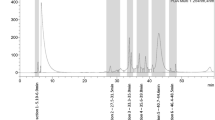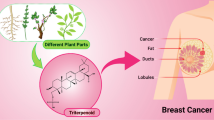Abstract
In our screening projects for anticancer agents from natural resources, artocarpin [6-(3-methyl-1-butenyl)-5,2′,4′-trihydroxy-3-isoprenyl-7-methoxyflavone] isolated from wood of jack fruit (Artocarpus heterophyllus) showed potent cytotoxic activity on human T47D breast cancer cells. The mode of action of artocarpin was evaluated by its effect on cell viability, nuclear morphology, cell cycle progression, expression of protein markers for apoptosis, and mitochondrial membrane potential (Δψm). These results showed that artocarpin caused a reduction of cell viability in a concentration-dependent manner and an alteration of cell and nuclear morphology. Moreover, the percentage of the sub-G1 phase formation was elevated dose-dependently. Artocarpin induced activation of caspase 8 and 10 as indicated by stronger signal intensity of cleaved-caspase 8 and weaker signal intensity of caspase 10 markers detected after artocarpin treatment. In addition, we also noticed the activation of caspase 3 by artocarpin. There were negligible changes in mitochondrial membrane potential (Δψm) due to artocarpin treatment. All together, these data indicated that artocarpin induced apoptosis in T47D cells possibly via an extrinsic pathway.






Similar content being viewed by others
References
Liu Y, Wang MW (2008) Botanical drugs: challenges and opportunities Contribution to Linnaeus Memorial Symposium 2007. Life Sci 82:445–449
Gupta R, Gabrielsen B, Ferguson SM (2005) Nature’s medicines: traditional knowledge and intellectual property management. Case studies from the National Institutes of Health (NIH), USA. Curr Drug Discov Technol 2:203–219
Barron D, Di Pietro A, Dumontet C, McIntosh DB (2002) Isoprenoid flavonoids are new leads in the modulation of chemoresistance. Phytochem Rev 1:325–332
Di Pietro A, Conseil G, Peres-Victoria JM, Dayan G, Baubichon-Cortay H, Trompier D, Steinfels E, Jault JM, de Wet H, Maitrejean M, Comte G, Boumendjel A, Mariotte AM, Dumontet C, McIntosh DB, Goffeau A, Castanys S, Gamarro F, Barron D (2002) Modulation by flavonoids of cell multidrug resistance mediated by P-glycoprotein and related ABC transporters. Cell Mol Life Sci 59:307–322
Botta B, Vitali A, Menendez P, Misiti D, Monache GD (2005) Prenylated flavonoids: pharmacology and biotechnology. Curr Med Chem 12:713–739
Cidade HM, Nacimento MS, Pinto MM, Kijjoa A, Silva AM, Herz W (2001) Artelastocarpin and carpelastofuran, two new flavones, and cytotoxicities of prenyl flavonoids from Artocarpuse elasticus against three cancer cell lines. Planta Med 67:867–870
Ko HH, Lu YH, Yang SZ, Won SJ, Lin CN (2005) Cytotoxic prenylflavonoids from Artocarpus elasticus. J Nat Prod 68:1692–1695
Watjen W, Weber N, Lou YJ, Wang ZQ, Chovolou Y, KampkÖtter A, Kahl R, Proksch P (2007) Prenylation enhances cytotoxicity of apigenin and liquiritigenin in rat H4IIE hepatoma and C6 glioma cells. Food Chem Toxicol 45:119–124
Wang YH, Hou AJ, Chen L, Chen DF, Sun HD, Zhao QS, Bastow KF, Nakanish Y, Wang XH, Lee KH (2004) New isoprenylated flavones, artochamins A-E, and cytotoxic principles from Artocarpus chama. J Nat Prod 67:757–761
Arung ET, Shimizu K, Ryuichiro K (2006) Inhibitory effect of artocarpanone from Artocarpus heterophyllus on melanin biosynthesis. Biol Pharm Bull 29:1966–1969
Arung ET, Shimizu K, Ryuichiro K (2006) Inhibitory effect of isoprenoid-substituted flavonoids isolated from Artocarpus heterophyllus on melanin biosynthesis. Planta Med 72:847–850
Jamil K, Shaik AP, Mahboob M, Krishna D (2004) Effect of organophosphorus and organochlorine pesticides (Monochrotophos, chlorpyriphos, dimethoate, and endosulfan) on human lymphocytes in vitro. Drug Chem Toxol 27:133–144
Sandra F, Matsuda M, Yoshida H, Hirata M (2002) Inositol hexakisphospahate blocks tumor cell growth by activating apoptotic machinery as well as by inhibiting the Akt/NFkB-mediated cell survival pathway. Carcinogenesis 23:2031–2041
Sandra F, Hendarmin L, Nakao Y, Nakao Y, Nakamura N, Nakamura S (2005) TRAIL cleaves caspase-8, -9 and -3 of AM-1 cells: a possible pathway for TRAIL to induce apoptosis in ameloblastoma. Tumor Biol 26:258–264
Green DR, Reed JC (1998) Mitochondria and apoptosis. Science 281:1309–1312
Stridh H, Kimland M, Jones DP, Orrenius S, Hampton MB (1998) Cytochrome c release and caspase activation in hydrogen peroxide- and tributyltin-induced apoptosis. FEBS Lett 429:351–355
Shimizu K, Fukuda M, Kondo R, Sakai K (2000) The 5α-reductase inhibitory components from heartwood of Artocarpus incisus: structure–activity investigations. Planta Med 66:16–19
Rajendran M, Manisankar P, Gandhidasan R, Murugesan R (2004) Free radical scavenging efficiency of a few naturally occurring flavonoids: a comparative study. J Agric Food Chem 52:7389–7394
Lin CN, Lu CM (1996) Novel antiplatelet constituents from formosan Moraceous plants. J Nat Prod 59:834–838
Sato M, Fujiwara S, Tsuchiya H, Fujii T, Iinuma M, Tosa H, Ohkawa Y (1996) Flavones with antibacterial activity against cariogenic bacteria. J Ethnopharmacol 54:171–176
Itoigawa M, Ito C, Jun-Ichi M, Nobukuni T, Ichiishi E, Tokuda H, Nishino H, Furukawa H (2002) Cancer chemopreventive activity of flavanones on Epstein–Barr virus activation and two-stage mouse skin carcinogenesis. Cancer Lett 176:25–29
Arung ET, Yoshikawa K, Shimizu K, Ryuichiro K (2010) Isoprenoid-substituted flavonoids from wood of Artocarpus heterophyllus on B16 melanoma cells: cytotoxicity and structural criteria. Fitoterapia 81:120–123
Likhitwitayawuid K, Chaiwiriya S, Sritularak B, Lipipun V (2006) Antiherpetic flavones from the heartwood of Artocarpus gomezianus. Chem Biodivers 10:1138–1143
Han AR, Kang YJ, Windono T, Lee SK, Seo EK (2006) Prenylated flavonoids from the heartwood of Artocarpus communis with inhibitory activity on lipopolysaccharideinduced nitric oxide production. J Nat Prod 69:719–721
Shimizu K, Kondo R, Sakai K, Takeda N, Nagahata T (2002) The skin-lightening effects of artocarpin on UVB-induced pigmentation. Planta Med 68:79–81
Kerr JFR (1994) Apoptosis. Its significance in cancer and cancer therapy. Cancer 73:2013–2026
Degterev A, Boyce M, Yuan J (2003) A decade of caspases. Oncogene 22:8543–8567
Mor G, Montagna MK, Alvero AB (2008) Modulation of apoptosis to reverse chemoresistance. Apoptosis and cancer, methods and protocols. Humana, Totowa
Zamzami N, Susin SA, Marchetti P, Hirsch T, Gómez-Monterrey I, Castedo M, Kroemer G (1996) Mitochondrial control of nuclear apoptosis. J Exp Med 183:1533–1544
Li P, Nijhawan D, Budihardjo I, Srinivasula SM, Ahmad M, Alnemri ES, Wang X (1997) Cytochrome c and dATP-dependent formation of Apaf-1/caspase-9 complex initiates an apoptotic protease cascade. Cell 91:479–489
Colgate EC, Miranda CL, Stevens JF, Bray TM, Ho E (2007) Xanthohumol, a prenylatedflavonoid derived from hops induces apoptosis and inhibits NF-kappaB activation in prostate epithelial cells. Cancer Lett 246:201–209
Watjen W, Suckow-Schnitker AK, Rohrig R, Kulawik A, Addae-Kyereme J, Wright CW, Passreiter CM (2008) Prenylation flavonoid derivatives from the bark of Erythrina addisoniae. J Nat Prod 71:735–738
Chen CN, Wu CL, Lin JK (2007) Apoptosis of human melanoma cells induced by the novel compounds propolin A and propolin B from Taiwanese propolis. Cancer Lett 245:218–231
Lee C, Lin CN, Jow GM (2006) Cytotoxic and apoptotic effects of prenylflavonoid artonin B in human acute lymphoblastic leukemia cells. Acta Pharmacol Sin 27:1165–1174
Acknowledgments
T47D cells were generously donated by Tjandrawati Mozef, M.Sc., Indonesian Institute of Sciences Research Centre for Chemistry (Natural Products, Food and Pharmaceuticals Division), Bandung, Indonesia.
Author information
Authors and Affiliations
Corresponding author
Rights and permissions
About this article
Cite this article
Arung, E.T., Wicaksono, B.D., Handoko, Y.A. et al. Cytotoxic effect of artocarpin on T47D cells. J Nat Med 64, 423–429 (2010). https://doi.org/10.1007/s11418-010-0425-6
Received:
Accepted:
Published:
Issue Date:
DOI: https://doi.org/10.1007/s11418-010-0425-6




